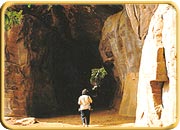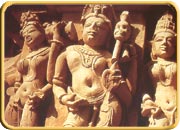Wednesday, 24 February 2016
|
 Madhya
Pradesh occupies perhaps the oldest part of the subcontinent. Close to Bhopal
at Bhimbetka are the pre-historic caves that preserve some fascinating paintings
dating back to Paleolithic times. Experts have concluded that these are at least
as old as the specimen at Pyrnees.
Madhya
Pradesh occupies perhaps the oldest part of the subcontinent. Close to Bhopal
at Bhimbetka are the pre-historic caves that preserve some fascinating paintings
dating back to Paleolithic times. Experts have concluded that these are at least
as old as the specimen at Pyrnees. was
broken up into small principalities contending forever to establish their supremacy
over one another. Chandels were one such dynasty claiming descent from the moon,
who carved out a strong prosperous kingdom for themselves after the decline
of the great empire. There was a short spell of inspired construction activity
under the Chandels in the 10th to 11th centuries. They are the ones who have
left behind the cluster of matchless temples at Khajuraho.
was
broken up into small principalities contending forever to establish their supremacy
over one another. Chandels were one such dynasty claiming descent from the moon,
who carved out a strong prosperous kingdom for themselves after the decline
of the great empire. There was a short spell of inspired construction activity
under the Chandels in the 10th to 11th centuries. They are the ones who have
left behind the cluster of matchless temples at Khajuraho. |
|
||||